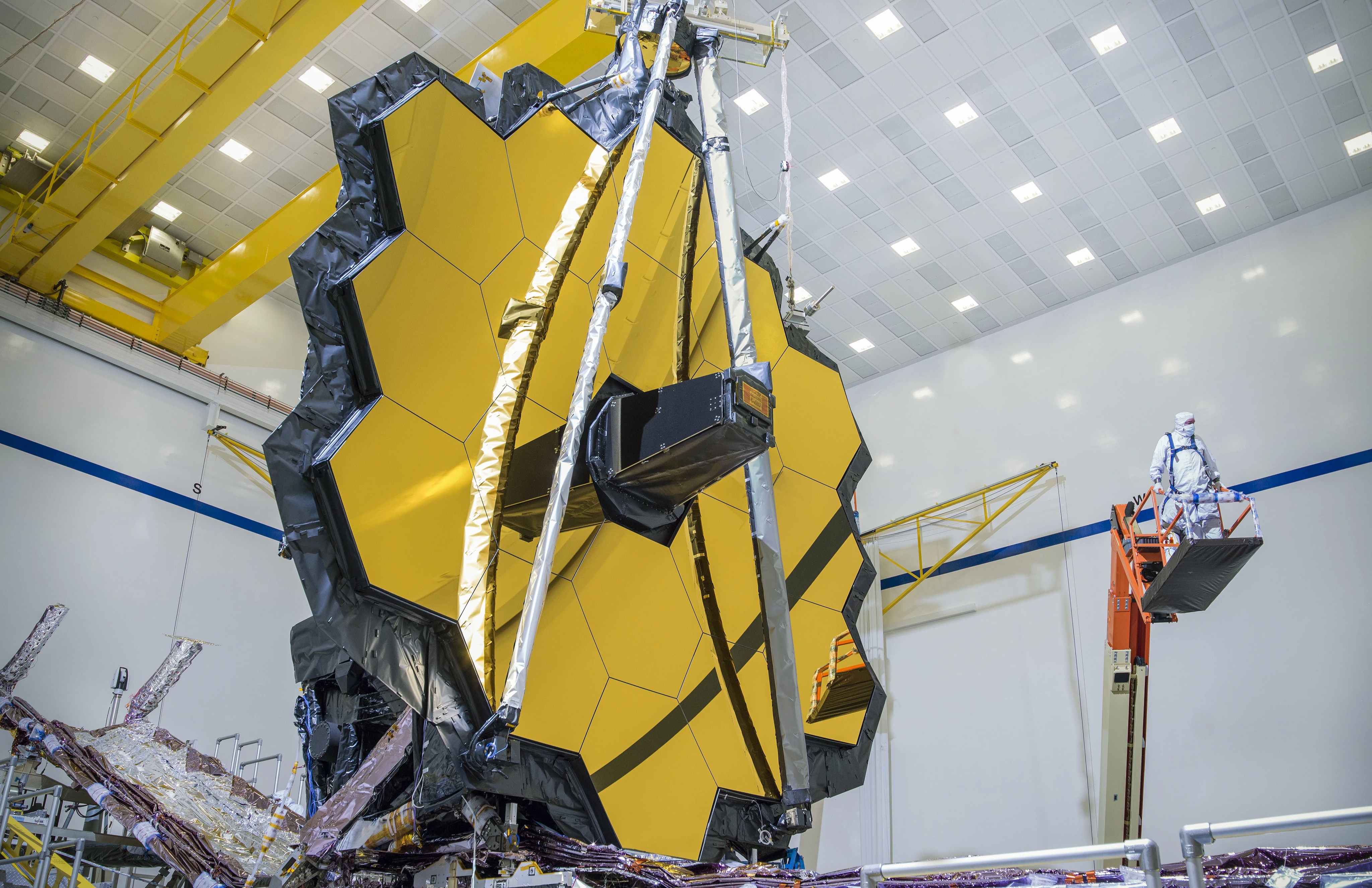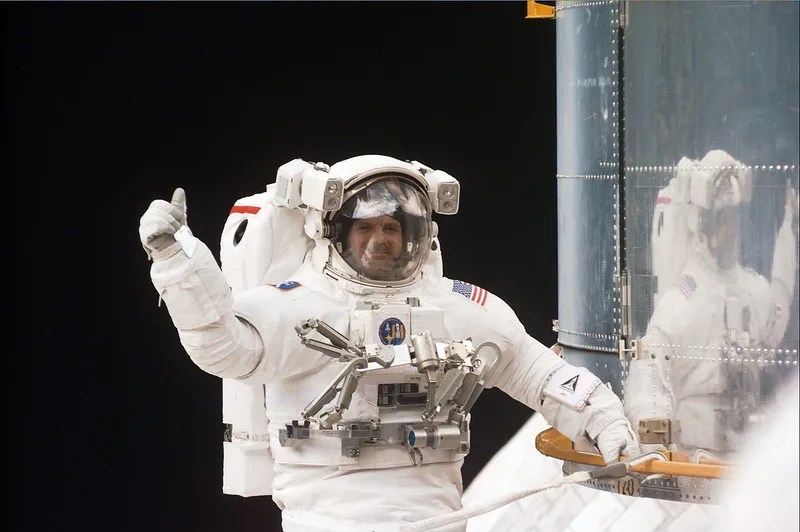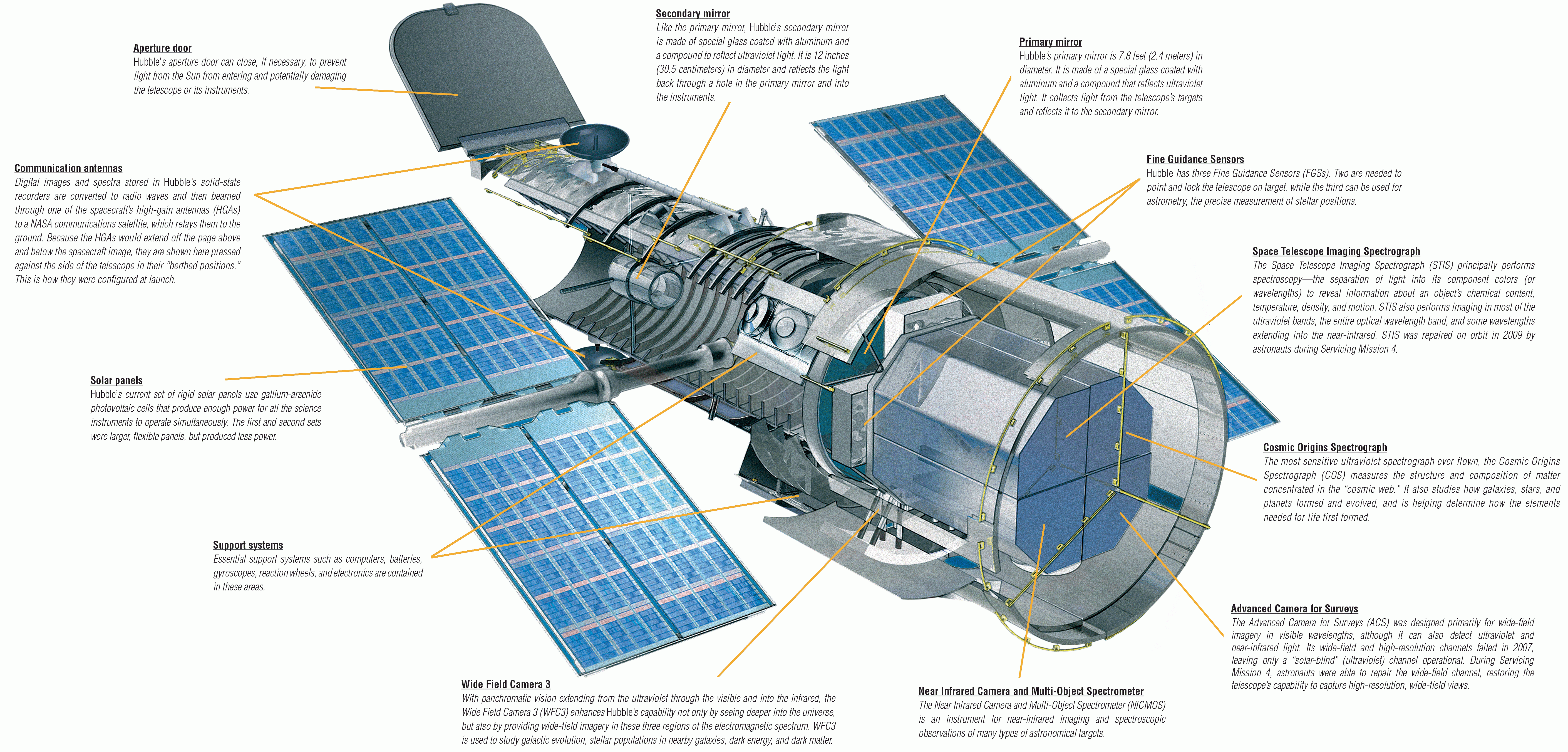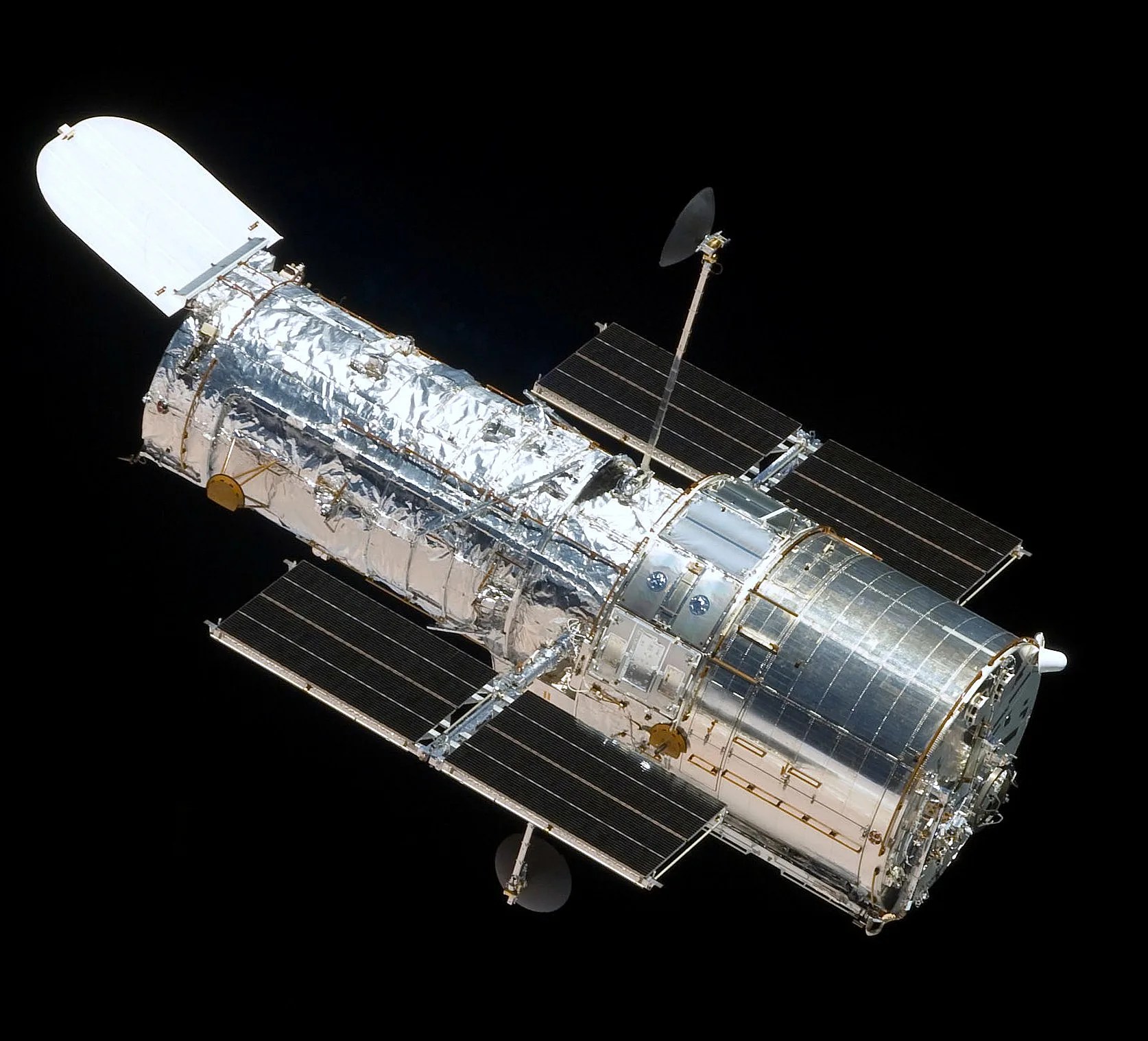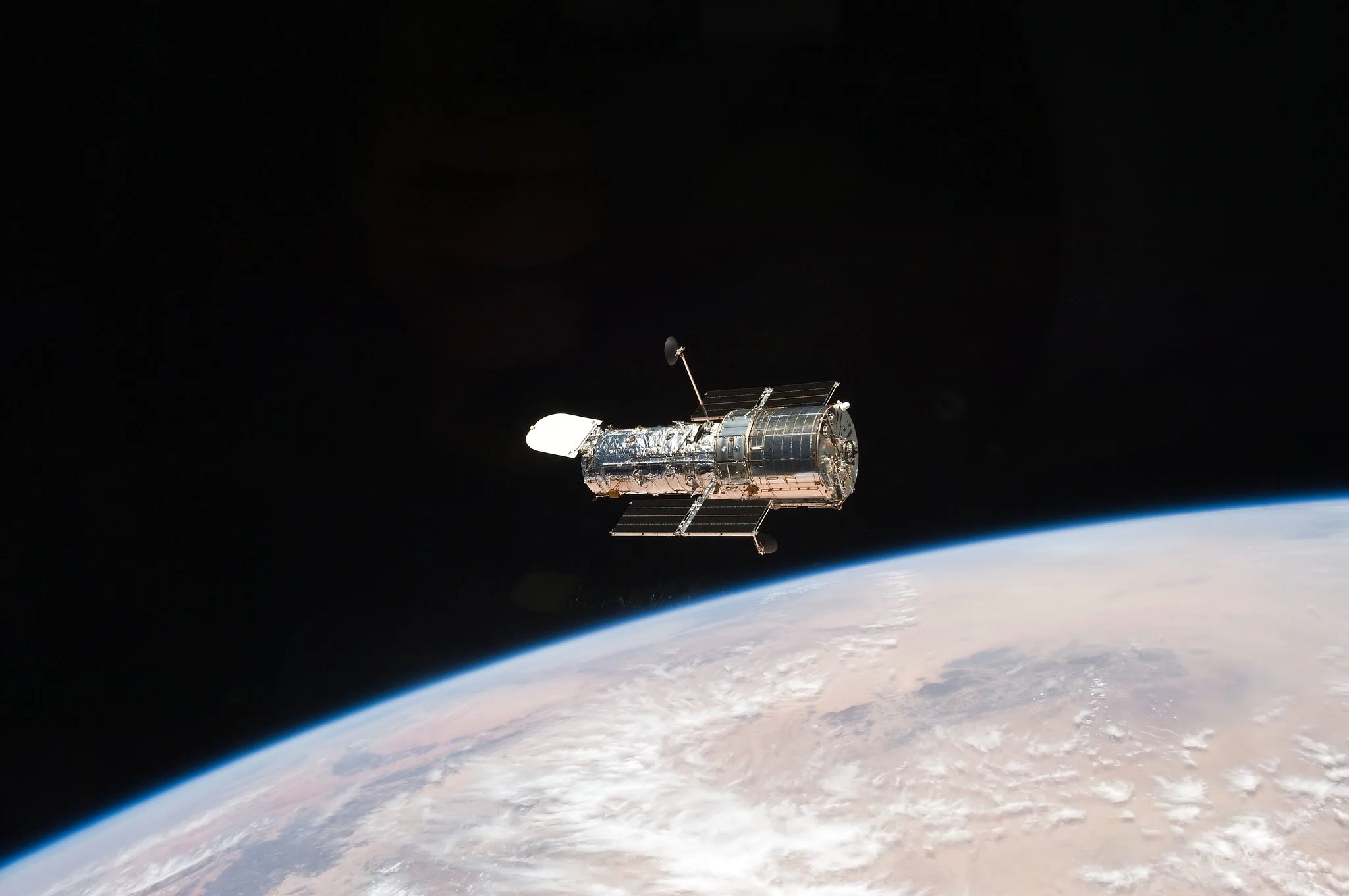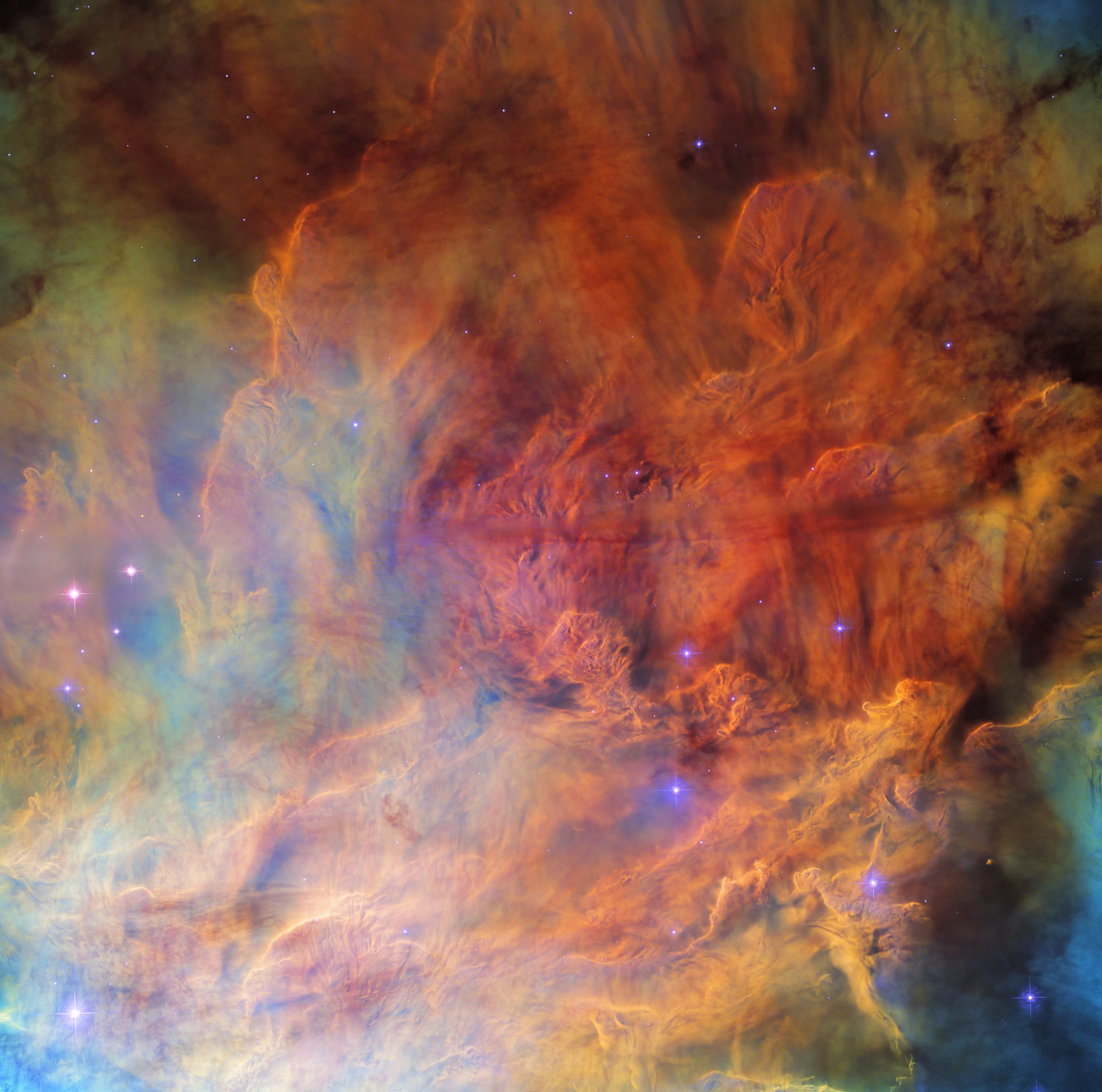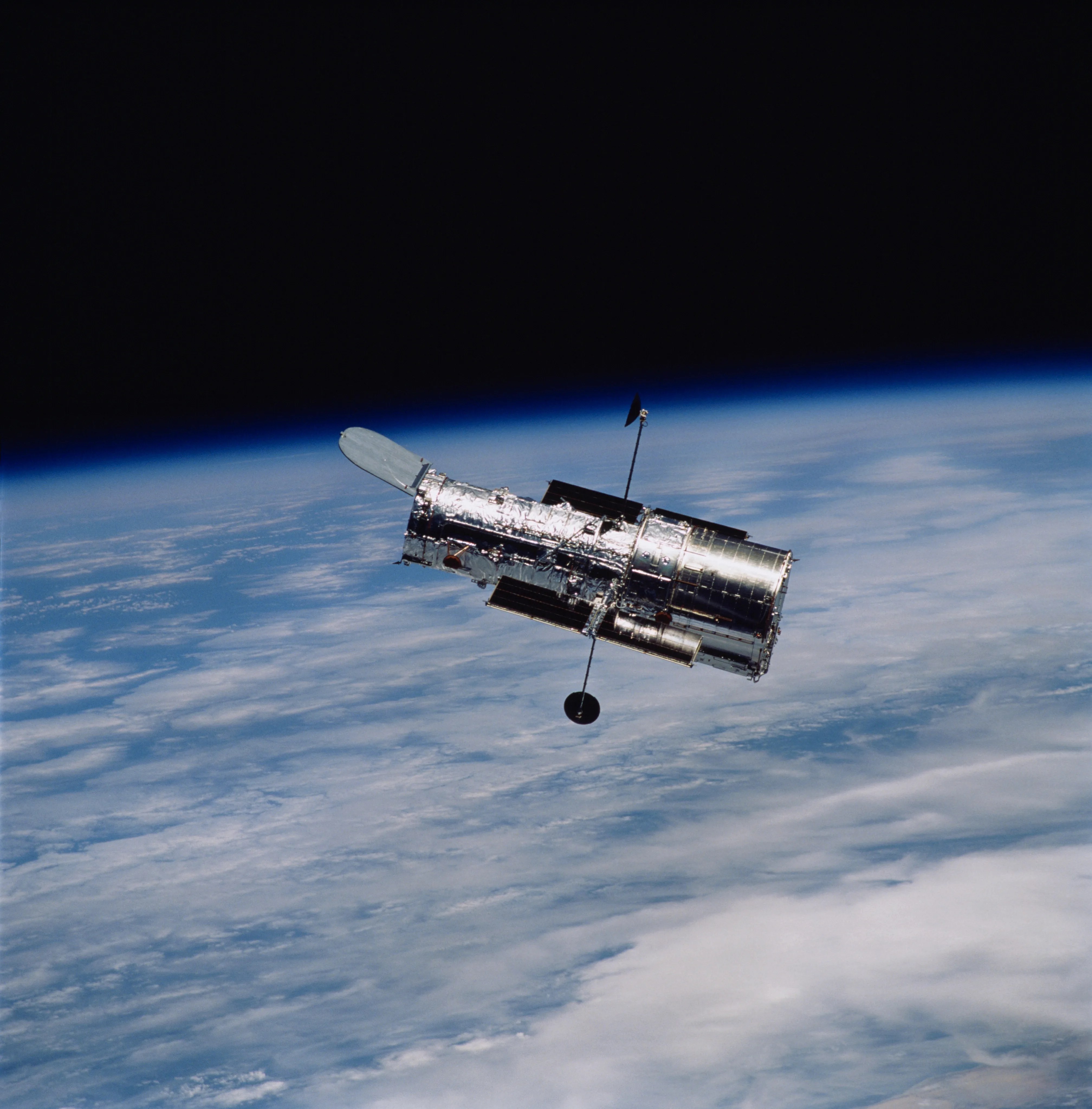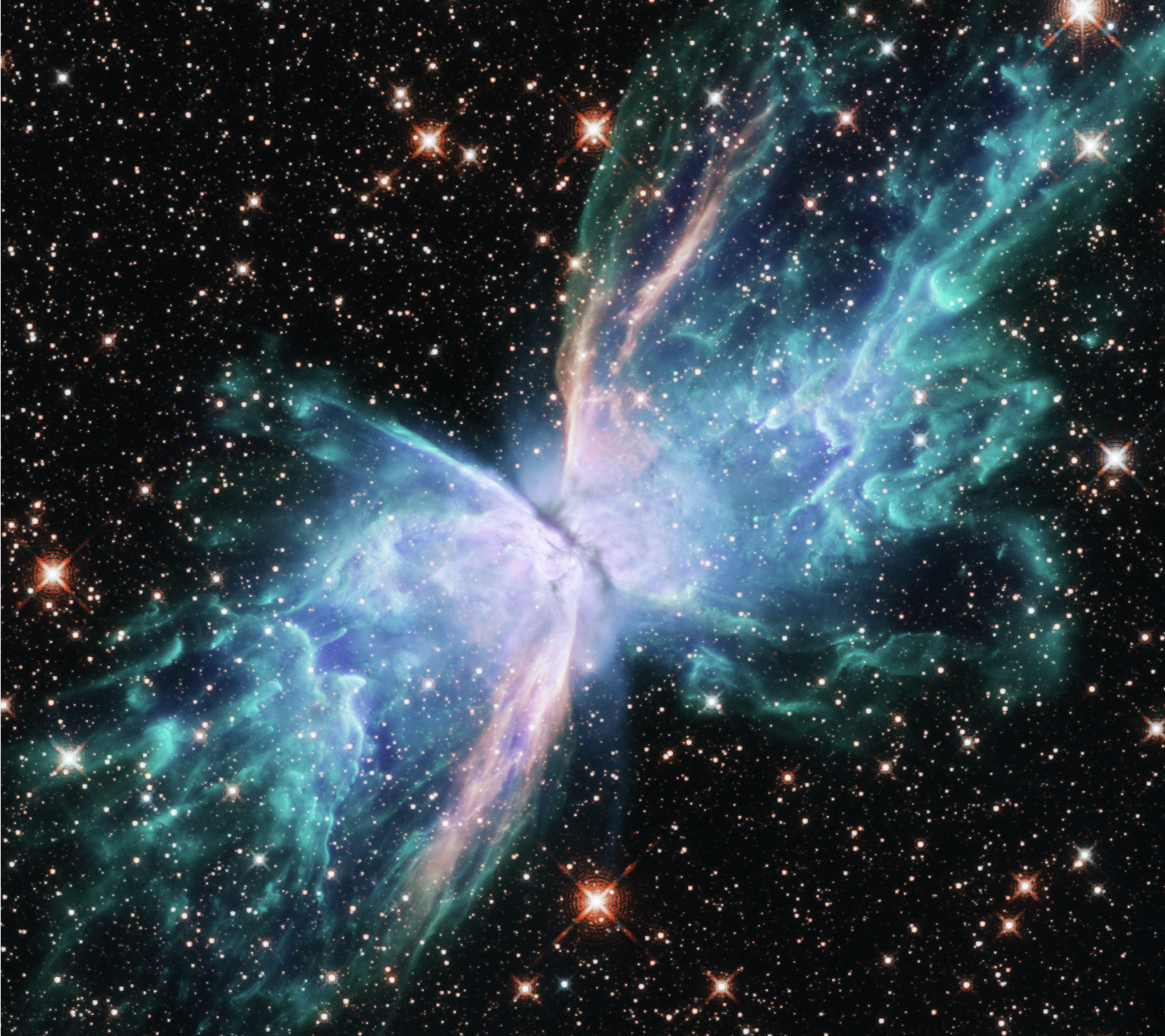Observatory
On The Shoulders of a Giant
Hubble and Webb work together to explore the cosmos. Their observations complement each other, providing us with a broad view of the universe.
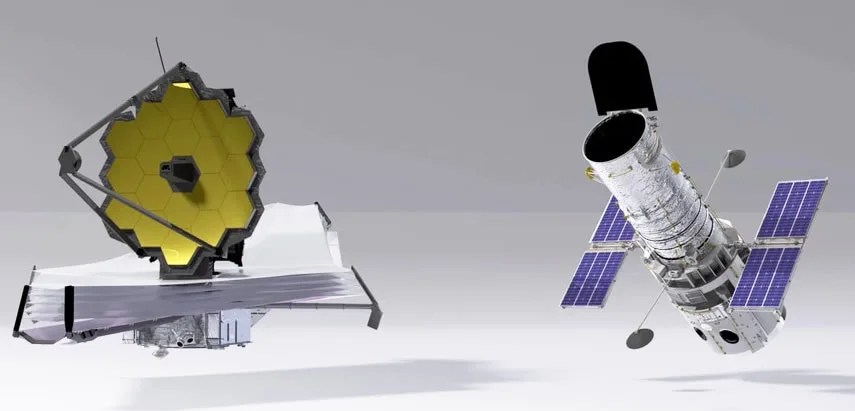
Overview
In 1675, famed physicist and mathematician, Isaac Newton, penned a letter to his contemporary and rival, polymath Robert Hooke. In that letter, Newton wrote what would become one of his most famous remarks: “If I have seen further, it is by standing on the shoulders of giants.” Over time, this simple statement has come to represent the process of science itself, each new discovery building upon previous work. The same is true for NASA’s Hubble Space Telescope and its observing partner, NASA’s James Webb Space Telescope.
Since its 1990 launch, the Hubble Space Telescope has given humanity a unique perspective of the universe. From its vantage point above Earth’s light-distorting atmosphere, Hubble offers us clear, detailed views that reach farther out in space and further back in time than any of its predecessors. Hubble’s observations have charted the evolution of galaxies, stars, nebulae, comets, the outer planets, and their moons. Hubble’s discoveries have confirmed the existence of black holes in galaxy cores, measured the composition of exoplanet atmospheres, found the most distant galaxies to date, and verified the accelerating expansion of the universe – a 2011 Nobel Prize winning discovery in physics. Hubble’s findings have affected all aspects of astronomy, prompting further research and revisions to textbooks, but its observations have captured more than our scientific curiosity. Today we find Hubble’s iconic images on lunchboxes, coffee mugs, socks, neckties, and even moving vans. For more than 30 years, Hubble has spurred our imaginations, inspiring our desire to learn more. To do that, we need to see farther and deeper.
NASA-GSFC; Lead Producer: Paul Morris
State of the Art Observatories
The James Webb Space Telescope is the largest, most technically advanced telescope ever built. Its larger size and richer infrared views allow it to go beyond Hubble’s Deep Field observations to peer back over 13.5 billion years, witnessing the first stars and galaxies forming out of the darkness of the early universe. By comparing the faintest and earliest galaxies to the majestic spiral and elliptical galaxies we see today, Webb’s observations can guide our understanding of how galaxies evolve over billions of years, building upon the work of astronomer Edwin Hubble and his namesake telescope.
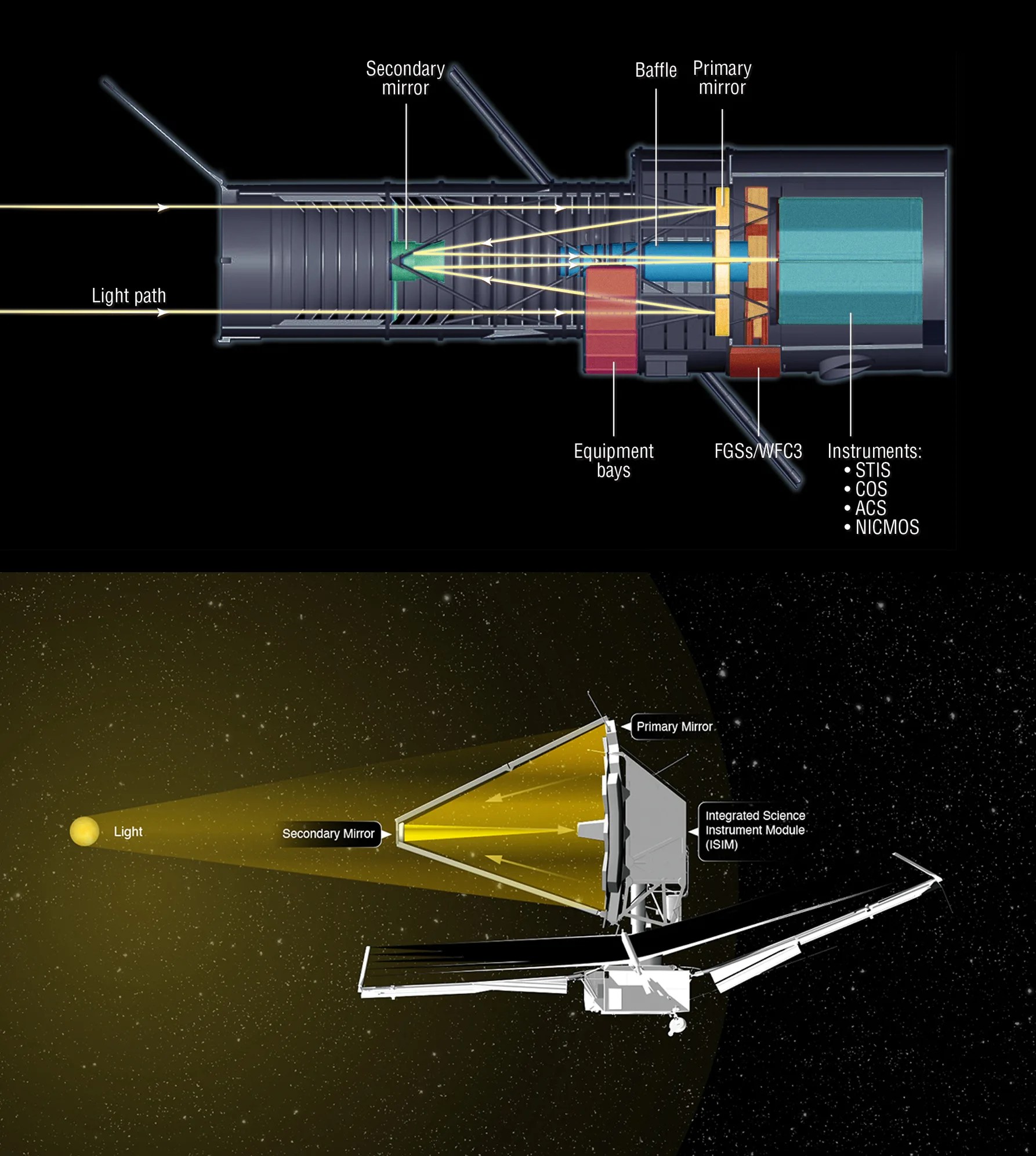
Webb’s deeper infrared vision (0.6 microns to 28.5 microns) cuts through the dust and gas of massive clouds where stars and planetary systems form. It goes beyond Hubble’s infrared view to further study distant exoplanet atmospheres, perhaps finding the building blocks of life elsewhere in the universe.
Hubble can observe in near-infrared light, but it was optimized for shorter ultraviolet and visible wavelengths of light (0.1 microns to 2.5 microns). This difference makes Hubble and Webb a formidable pair of observatories that together cover a broad wavelength range.
Design
Both Hubble and Webb are reflecting telescopes. They use curved mirrors instead of lenses to collect and "bend" light to their various instruments. Many reflecting telescopes have two main curved optics – a large, concave (shallow bowl shape) main or primary mirror and a much smaller, convex (slightly arching) secondary mirror positioned directly above the primary mirror. Such Cassegrain designs offer a long focal length (the length of the path that incoming light takes to come into focus) in a relatively compact package by "folding" the light path back and forth. The longer the focal length relative to the diameter of the main or primary mirror, the higher the magnification and depth of field. However, Webb is a Three-Mirror Anastigmat design which incorporates a third, or tertiary, curved mirror to achieve better optical performance over a wider field compared to Hubble’s Ritchey-Chrétien Cassegrain design.
Although both Hubble and Webb are reflecting telescopes, a quick look at each of them reveals some obvious differences. Because Hubble observes the universe from an orbit just above Earth’s atmosphere, it needs to block stray light from the Sun, and reflected sunlight from Earth and the Moon, from entering the telescope. To accomplish this, its forward assembly is wrapped with an insulated, aluminized Teflon light shield, creating the telescope’s “tube” shape. Webb’s large, multi-layered sunshield looks nothing like Hubble’s tubular light shield, but it serves the same purpose.
NASA-GSFC; Lead Producer: Michael McClare
Mirrors
Webb’s 21.3-foot (6.5-meter) primary mirror is also significantly larger than Hubble’s 7.9-foot (2.4-meter) primary mirror, giving Webb more than six times the light collecting area that Hubble has. This is important at the longer and dimmer wavelengths of light Webb sees. Because the universe is expanding, light from distant objects is stretched as it travels to Earth. Shorter, bluer wavelengths of light get stretched toward longer, redder wavelengths. Distant objects that are bright in ultraviolet or blue light will appear redder, or redshifted, when their light reaches Earth. They are also significantly dimmer. Webb’s larger primary mirror will gather more of this redshifted and dim light, providing us with views of objects up to 100 times fainter than Hubble can see. Despite its larger size, Webb delivers about the same resolution in near-infrared light as Hubble attains in visible light. A telescope’s resolution, the amount of discernable detail, is proportional to mirror size, and inversely proportional to the wavelength of the light observed. For Webb to resolve the same level of detail at longer wavelength infrared light that Hubble achieves at visible wavelengths, its mirror needs to be proportionally wider. With similar resolutions, the two telescopes can “double-team” their observations of objects to provide us with spectacular, broad-spectrum views.
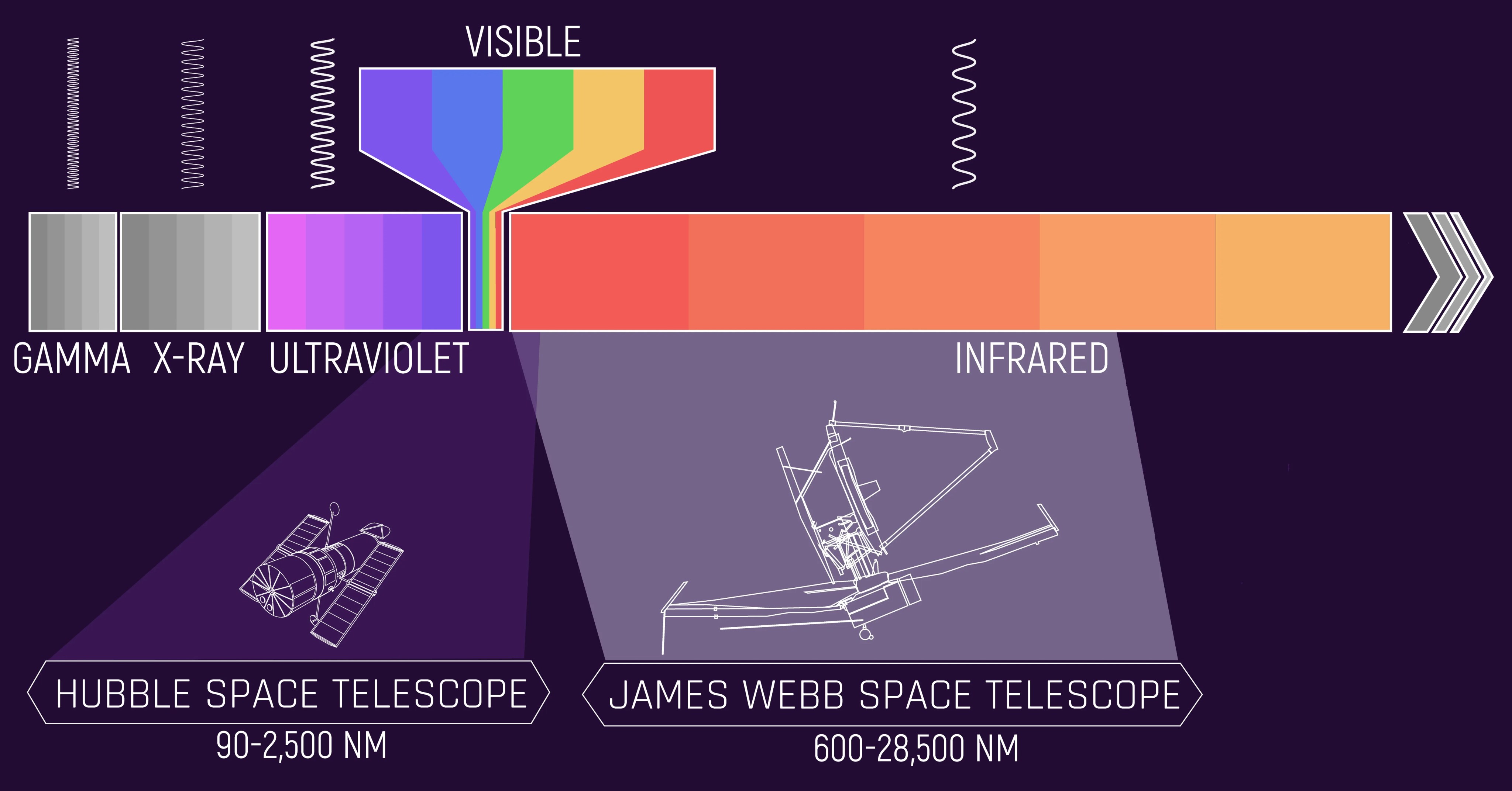
Hubble’s primary mirror is made of one large piece of Ultra-Low Expansion Glass® that is coated with thin layers of aluminum and magnesium fluoride. The layer of aluminum is only 3/1,000,000th of an inch thick and provides the mirror’s reflectivity. The magnesium fluoride layer is coated on top of the aluminum to protect it from oxidation as well as to increase reflectivity of ultraviolet light.
At 1,825 pounds (828 kg), Hubble’s mirror alone weighs nearly one ton. A Webb-sized primary mirror made out of the same material would be too heavy to launch into orbit. To solve this problem, Webb’s mirror is made of beryllium, which is both strong and light, and comprised of 18 hexagonal segments, each 4.3 feet (1.32 meters) in diameter and weighing roughly 46 pounds (21 kg). Webb’s mirror segments are covered in a microscopically thin, reflective layer (about 0.12 of an ounce) of gold. Gold reflects infrared light more efficiently making Webb extremely sensitive to infrared wavelengths.
Each of Webb’s 18 hexagonal mirror segments, as well as its secondary mirror, have a series of tiny mechanical motor assemblies, called actuators, that move each one in 3-dimentional space to bring them into proper alignment with each other. Each primary mirror segment also has an additional actuator dedicated to changing its curvature. This enables all 18 segments to share the same precise focal length that, when combined with positioning, is necessary for all 18 segments to act as one single large primary mirror.
Hubble has 24 actuators attached to the back of its mirror. Because Hubble’s mirror is made of one piece of glass, its actuators are arranged in two concentric circles. They can make small corrections to the shape of the mirror to compensate for very small thermal distortions, but not enough to significantly adjust its figure.
Because Hubble is optimized for ultraviolet and visible light, its primary mirror does not need to be as cold as Webb’s. More than 200 thermal sensors help maintain Hubble’s instruments and components at optimal temperatures and an array of heaters warms the back of Hubble’s primary mirror, where a large optical bench houses the observatory’s science instruments. This bench, called the Focal Plane Structure, needs to be stiff and thermally stable. Hubble’s heaters maintain a temperature of 70 degrees F (21 degrees C), which in turn maintains the stability of the optical bench.
Orbits
To capture those longer, fainter, infrared wavelengths of light, Webb not only needs to be larger, but much colder than Hubble. Unlike the rainbow colors of visible light, we can’t see infrared light with our eyes, but we can feel it. Infrared light is heat, or thermal radiation. It is the warmth you feel when you turn your face toward the Sun, or the heat radiating from a pot on the stove. Capturing the remnant heat from objects so far away means Webb needs to be extremely cold (-364 degrees F or -220 degrees C). So cold, in fact, that it must shield itself from the infrared radiation emanating from the Sun, Earth, and Moon. To do that, it needs to be much farther from Earth than Hubble is.
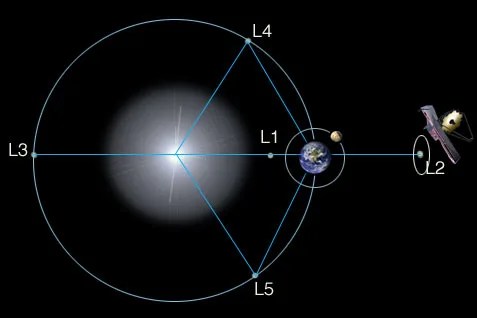
Hubble orbits Earth just above the atmosphere (320 miles or 515 km above Earth). Webb orbits the Sun with Earth, roughly one million miles away from home around the second Lagrange or L2 point. From Webb’s perspective, the Sun, Earth, and Moon will always be in the same part of the sky, allowing its enormous sunshield to block their light and keep the telescope cool. An added benefit, the gravitational forces of the Sun and Earth make L2 an easy place for the telescope to hold its orbit. At L2, Webb will only needs occasional, modest rocket thrusts to maintain a steady orbit.
Hubble’s close proximity to Earth requires it to deal with a dent in our magnetic field. This dent, called the South Atlantic Anomaly, collects charged particles from the Sun that can disrupt communications, and can cause problems with electrical systems. Hubble passes through this region for 10 consecutive orbits each day, nearly 15 percent of its time.
NASA-GSFC; Lead Producer: Michael McClare
Servicing Missions
Because Hubble circles just above Earth’s atmosphere, astronaut servicing missions with the potential return of Hubble to Earth for a refit, were part of its long-term plan. As a result, the telescope’s design reflects the dimensions of its launch and repair vehicle. Hubble fit snugly inside the Space Shuttle’s cargo bay. At roughly one million miles from Earth (four times farther from Earth than the Moon), there is no current servicing capability or plan for Webb. The telescope’s design does not rely on servicing missions.
Hubble Lends a Helping Hand
Hubble has supported several of NASA’s most important missions and worked with other space- and ground-based observatories to further our…
Read the Story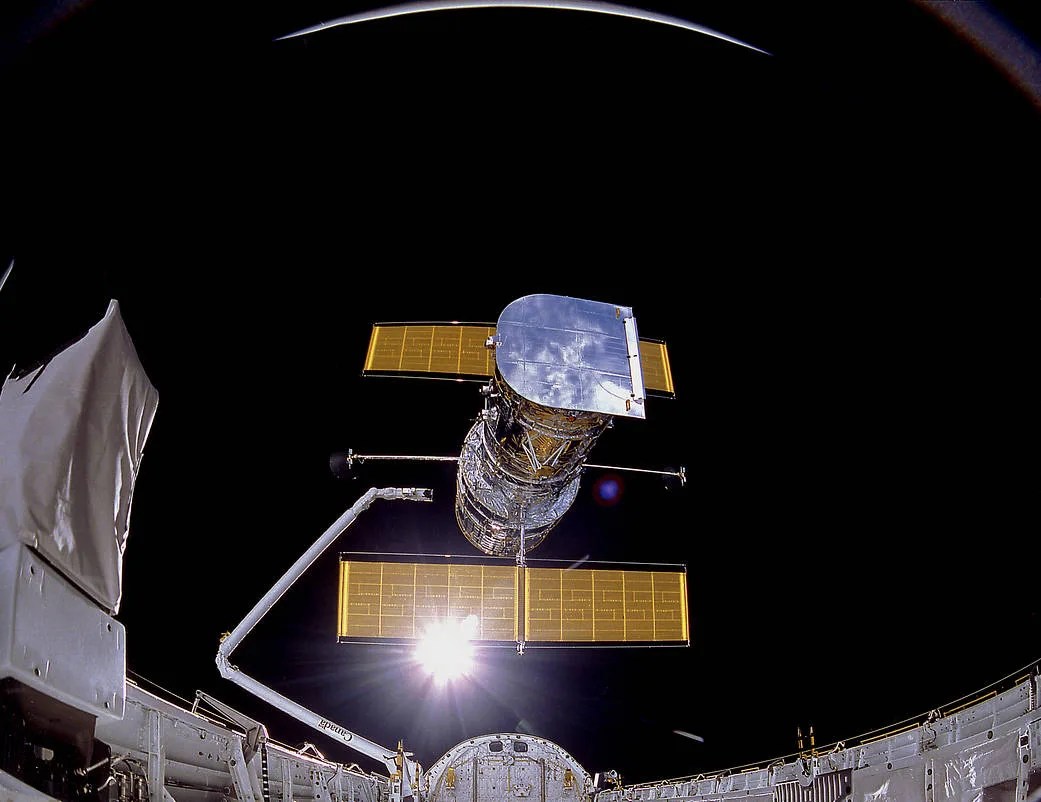
A New Golden Age of Astronomy
Like the launch of Hubble in 1990, the launch of Webb has ushered in a new era of observational astronomy. Standing on the shoulders of Hubble, Webb is seeing beyond the veteran observatory’s infrared vision and expanding our perspective to the far reaches of the universe. Working with Webb, Hubble’s visible and ultraviolet vision complements Webb’s infrared views. This powerful duo provides us with staggering cosmic vistas, the likes of which we have only imagined.
NASA-GSFC; Lead Producer: Paul Morris

